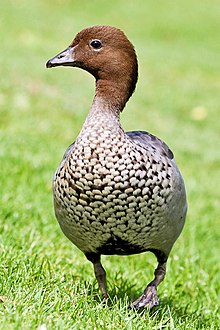Chenonetta
| Australian wood duck | |
|---|---|
 |
|
| Adult female | |
 |
|
| Adult male | |
| Scientific classification | |
| Kingdom: | Animalia |
| Phylum: | Chordata |
| Class: | Aves |
| Order: | Anseriformes |
| Family: | Anatidae |
| Subfamily: | Anatinae or Tadorninae |
| Genus: |
Chenonetta Brandt, 1836 |
| Species: | C. jubata |
| Binomial name | |
|
Chenonetta jubata (Latham, 1801) |
|
 |
|
| Range in red | |
The Australian wood duck, maned duck or maned goose (Chenonetta jubata) is a dabbling duck found throughout much of Australia. It is the only living species in the genus Chenonetta. Traditionally placed in the subfamily Anatinae (dabbling ducks), it might actually belong to the subfamily Tadorninae (shelducks); the ringed teal may be its closest living relative.
The Australian wood duck was first described by the English ornithologist John Latham in 1801 under the binomial name Anas jubata.
The flightless New Zealand species Chenonetta finschi (Finsch's duck) which was formerly believed to constitute a monotypic genus (Euryanas) has been determined to belong to Chenonetta. It became extinct before scientists could properly survey the New Zealand avifauna, but possibly as late as 1870 (based on a report of a flightless goose caught in Opotiki.)
This 45–51 cm duck looks like a small goose, and feeds mostly by grazing in flocks.
The male is grey with a dark brown head and mottled breast. The female has white stripes above and below the eye and mottled underparts. Both sexes have grey wings with black primaries and a white speculum. Juveniles are similar to adult females, but lighter and with a more streaky breast.
The Australian wood duck is widespread in Australia, including Tasmania. The Australian wood duck is found in grasslands, open woodlands, wetlands, flooded pastures and along the coast in inlets and bays. It is also common on farmland with dams, as well as around rice fields, sewage ponds and in urban parks. It will often be found around deeper lakes that may be unsuitable for other waterbirds' foraging, as it prefers to forage on land.
The most common call is a loud, rising croaky gnow sound by the females, and the male call is the same except smoother, shorter and higher than the females. Staccato chattering is also present in flocks.
...
Wikipedia

